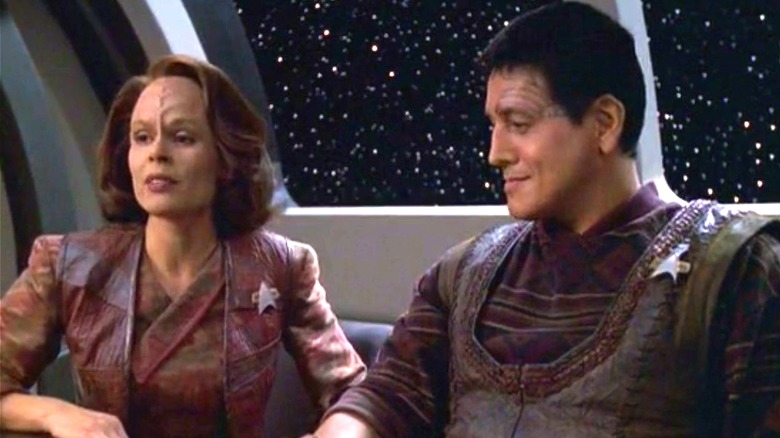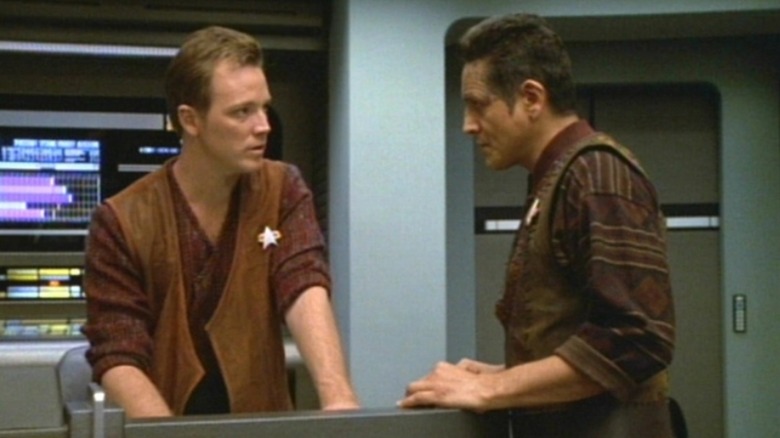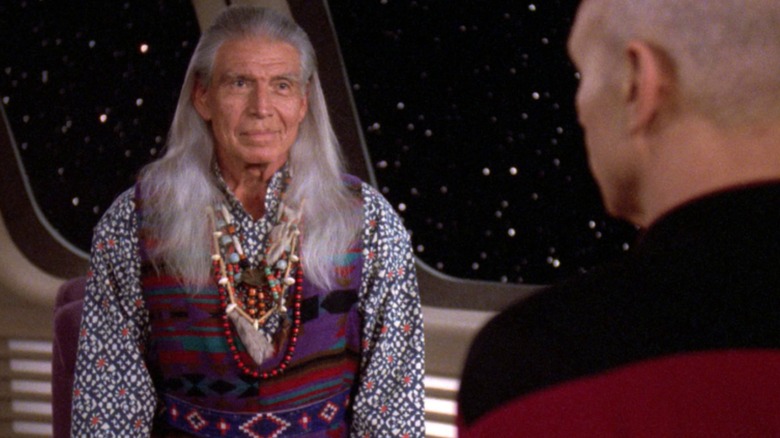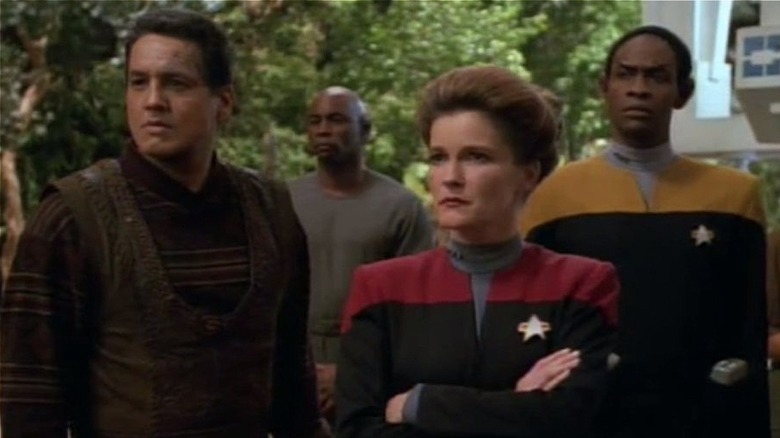This Star Trek: Voyager Pilot Moment Killed The Entire Series, According To A Producer
After watching two generations of Starfleet officers diplomacy their way through the Milky Way's Alpha Quadrant, "Star Trek: Voyager" finally gave viewers a chance to step outside their galactic neighborhood and find out what's going on in the Delta Quadrant. But according to producer Ronald D. Moore, a single decision about the pilot's execution took away some of the meat and potatoes from this Trekilicious entrée.
Not long after the newly minted USS Voyager pursues a small band of Maquis into the Badlands only to find both ships teleported to the Delta Quadrant 70,000 light years from Earth — a 75-year journey from home — the opposing sides end up joining their crews together ("Caretaker"). By the end of the pilot story arc, they're all standing on the bridge in their Starfleet uniforms and for the most part, working together save for a few lingering grumblings that pop up from time to time throughout the series.
According to writer and producer Ronald D. Moore, who joined the show's production team for its 6th season, the moment the Maquis donned their uniforms would come to define, and arguably kill, the series. Moore concluded in the book "The Fifty-Year Mission" (described as "The Complete, Uncensored, and Unauthorized Oral History of Star Trek"), "You'd think that's the setup for a major show about conflict, but at the end of the pilot they all put on the Starfleet uniforms and that's it. It was a huge mistake."
What a conflicted Maquis would look like
Ronald D. Moore's conclusion about the Maquis goes back to the roots of the Maquis storyline. According to Moore, who also worked as a producer and writer on "Star Trek: Deep Space Nine," the Maquis were created as a plot device for introducing "Voyager." He explained, "Here are Starfleet officers who had become terrorist resistance fighters, guerrilla warriors. The Federation has got them on the run and both of these groups are thrown in a ship on another side of the galaxy and forced to live together."
If Moore had the chance to reimagine the Voyager crew, they would be much less agreeable. He continued, "It should have been these two sides that were forced to work together that still don't like each other and still are gunning for each other, wondering who's going to come out on top. Who's going to betray who?"
But ultimately, that concept of the two sides trapped together who must work out their serious trust issues with nary a Counselor Troi on board felt a little too bleak for the network bosses. "It should have been gold, but they got scared," Moore continued, emphasizing that the ratings performance of the darker-toned "Deep Space Nine" had left them uneasy. Instead, Moore said, "They wanted a show that was more like Next Generation and easier to swallow and where people didn't have to think as much. So they drew all the wrong lessons and said, 'Let's play it safe.'"
Moore saw potential in Star Trek's Maquis
For TV screenwriter and producer Ronald D. Moore, exploring complex political issues through a more nuanced lens has always been integral to his writing no matter what he's working on. It forms a main thread throughout the reimagined "Battlestar Galactica," which ultimately explores the Cylon resistance through the lens of both the Colonial and the Cylon perspectives and from just about every imaginable angle. It's also present in "Outlander" as the series explores the Jacobite uprising and the American Revolution. So it should come as no surprise that Moore's hand was in the creation of the Starfleet resistance.
Star Trek's Maquis are inspired by their real-world namesakes: working-class antifascists from Nazi-occupied Vichy, France, who, when faced with the threat of conscription, imprisonment, deportation, or worse, took up armed resistance against their oppressors, calling themselves the Maquis. To our 21st-century sensibilities, it's hard to argue that the Maquis were in the right. Sabotage, sniping, bombings, surprise attacks — all of those seem forgivable when the cause is just. But often, distinguishing resistance fighters from terrorists is not so cut and dry, which is why filing the two crews' relationship status under "it's complicated" might have yielded more fertile ground for nuanced storytelling.
How Ronald D. Moore would do things differently
On paper, the Maquis seem like a perfect addition to a story that's meant to be layered with moral ambiguity. In the world of the original "Star Trek" series and "Star Trek: The Next Generation," Starfleet seems to corner the market on truth and post-scarcity ethics. But with the Maquis, we learn a bitter conflict left Federation colonies feeling abandoned to the point that they are willing to actively and often violently violate Federation treaties.
Though the Maquis are first seen in "Deep Space Nine," the story behind them begins all the way back in the "Next Generation" episode "Journey's End." This episode introduces Starfleet's intention to cede several colonized planets to the Cardassians in compliance with a new treaty — and the colonists aren't having it. In case the human toll isn't obvious on its face, many of the colonists are Native Americans with a recent cultural memory of their people's last forced relocation. In the end, the colonists choose to accept Cardassian rule rather than leave their homes.
But as relations between the colonists and Cardassians rapidly deteriorate, the fed-up colonists begin adopting guerilla tactics like rigging explosions aboard Cardassian targets and abducting Gul Dukat (in the "DS9" episodes "The Maquis, Part I" and "Part II").
With all of that history, some viewers may find it hard to swallow that the Maquis on "Voyager" are so willing to set aside their differences and go full Boimler right down to the com badges, no matter how far they find themselves from home. If the drama that unfolded when the Cylon and human survivors were forced together on "Battlestar Galactica" is any indication, Ronald D. Moore's amended version would certainly be worth watching. Only the omniscient Koala can know for sure.



